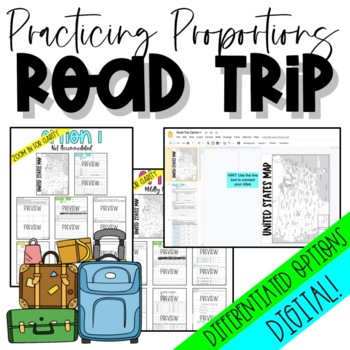Practice Proportions Road Trip Project | Google Slides™ for Distance Learning
- PDF
- Internet Activities
Description
This is a super fun differentiated end of the year project that uses proportions, ratios, division, addition, subtraction, multiplication, and real world scenarios! Students have been tasked with creating a summer road trip for their family. This project is broken down into three "days" (if you don't like calling it days, there is also an option that is called "step") where each day students are given a new packet and must solve a new task. The tasks are listed below.
Included:
-TWO GOOGLE DRIVE LINKS! One sends you to the accommodated packet and the other sends you to the regular packet
-THREE different packet options:
1. No accommodations
2. Accommodations
3. Utilizes "steps" instead of "days"
-Each packet contains a map and 7 pages of work
Tasks:
1. What cities will you visit? (Choose 5)
2. Use a ruler to connect your cities with a straight line
3. How many inches is each line in between cities?
4. Use the key to determine how many miles an inch is
5. Create a proportion to solve for the distance in miles of each line
6. Add up your miles to find total miles travelled
7. Choose a rental car! Solve for MPG of 6 different cars
8. Tell which car you chose and why
9. Calculate the cost of gas for each car using a proportion
10. Calculate the total fuel needed per car using a proportion
11. How long will you spend in each city? (sightseeing)
12. How long is your total vacation w/travel time?
13. Choose a hotel & calculate it's cost
14. How much will your meals cost?
15. How much does renting a rental car cost?
16. How much is your total trip?
I like to give my students a budget and reward a person who comes the closest to the budget and another reward for whoever saves the most money!
Enjoy!





